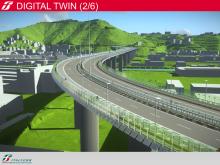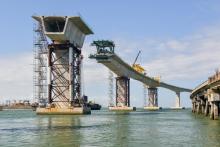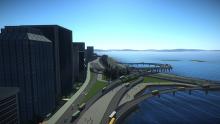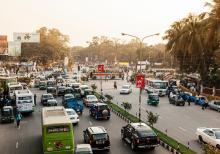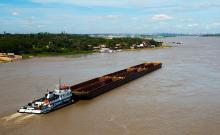The people of Dhaka have developed a level of traffic tolerance that far exceeds that of the normal city dweller. Travelling just 5km across Bangladesh’s capital by car and back can take up to four hours. Traffic congestion regularly brings the city to a standstill.
Despite Dhaka’s growing economy – high-rises adding to the skyline, increasing car-use and a proliferation of new places to spend disposable incomes – investment in transport infrastructure has struggled to keep up with the needs of a more affluent and mobile population. Private cars compete for space on the roads with buses, scooters, motorbikes, auto-rickshaws and rickshaws in the crowded city of 19.6 million people. Traffic lights and regulations are regularly ignored. The city’s seemingly expert drivers move forward wherever there is space, like liquid filling a vessel, as two and three-wheeled vehicles squeeze dangerously between cars and buses. There is little or no space for pedestrians and air quality is poor. With a climate of extremes between hot and wet weather, walking is a dangerous activity and not a viable option for most people.
A small country with big ambitions for further growth, it is working to reduce poverty. The proportion of its 163 million population in 2016 living below the poverty line has halved to 25% since 2000. But traffic congestion in and around Dhaka remains a barrier to progress, and a raft of solutions to alleviate the problem, including a new metro, guided bus route and several new road projects, are in the pipeline.
Deck construction using the truss launching system at the start of section one near Hazrat Shajalal International Airport
The 20km Dhaka Elevated Expressway Project (DEEP) will connect factories and an expanding international airport to the north of the city with the highway serving the main port of Chittagong to the south. It will cut journey times across the city from hours to minutes. Its distinctive Y-shaped concrete piers also add to the architecture of the city. With spans of up to 40m, the 9.4m wide dual carriageway will take traffic off the streets below at daily rates of around US$1.5/car and US$6/truck.
Currently, trucks only drive across the city at night when there is less traffic, limiting factory output and stifling growth. When DEEP is operational, goods can be transported 24/7, supporting the government’s development plans and the project has been welcomed by the city’s small business owners.
"Coordinating construction in such a congested city has been undoubtedly one of this project’s greatest challenges. The route has to interface with existing roads, railways, and lakes as well as the constant addition of new developments while always being mindful that parts of Dhaka habitually suffers extensive flooding," according to Mott MacDonald country director Ben Witjes.
DEEP also involves building 27km of ramps to connect it to the existing road network. At a height of 7.2m, and rising up to 23m above existing roads, railways and bridges, it is being delivered under a public-private partnership (PPP) agreement between the Bangladesh Bridge Authority (BBA) and contractor
FDEE will build, operate, maintain and manage the US$1.1 billion bypass for 25 years, including the three-and-a-half-years it will take to build it. Vehicles will be able to travel at 80km/hour on the new road when it is complete.
DEEP is being built in three sections: from Hazrat Shajalal International Airport to Banani (7.5km), Banani to Moghbazar (6km) and Moghbazar to Kutubkhali (6.5km), where it will join the N1 Dhaka-Chittagong highway.
Consultant Mott MacDonald is the project’s independent engineer, funded jointly by the concessionaire and Bangladesh government.
“Our role is to review every part of the project at all stages – from design, through construction, operation and maintenance. We flag up any concerns early and suggest improvements,” says Mott MacDonald team leader Imad Ahmed. A steep learning curve has accompanied the project as all parties develop a PPP mindset where decision-making is based on whole life benefits, rather than initial capital cost.
Imad moved from the UK to Dhaka in 2015. Since then, the firm’s role has expanded to cover construction supervision for the concessionaire to ensure the highest quality and safety standards. This role ranges from advising on personal protective equipment (PPE) to validating concrete strengths. It also involves meeting with local people affected by the project to ensure they receive adequate compensation when land is acquired for the project. On a day-to-day level, the firm reviews traffic management plans produced by FDEE.
“We suggested reducing the viaduct height so that it would be quicker and cheaper to build,” said Imad. Originally, Bangladesh Railway (BR) required the stretches of the expressway straddling the railway tracks to have vertical clearance of 15m above the tracks, he explained. But a lower clearance would mean shorter ramps, reducing both the amount of land required and the cost of construction.
“We met with BR to understand their concerns and realised that the 15m clearance was based on the height of a track-side crane needed to remove a train if there was an accident. So, we examined more compact, mobile cranes and worked out where it needed to be positioned to do the same job. When we put this solution to the team, with the news that clearance could be reduced to 9.5m in these locations, FDEE and Bangladesh Bridge Authority were happy to purchase one for BR to secure programme and construction gains,” he said.
Most of the 89ha site for the expressway is owned by the government, but 11ha is private land. It took almost three years of advance works to resettle homes and businesses, divert utilities and clear the route for section one before construction could get underway. Rapid development in Dhaka means there were few reliable sources of as-built information to assist planning and design. Where structures and buried services have appeared on the route since the expressway’s plans were first approved, either the expressway structure has been adapted or the obstruction removed or diverted.
In low-lying countries like Bangladesh, where rivers split and spread before entering the sea and flooding is common, construction is prohibited in lakes or ditches because they store water during the monsoon season. So, where the expressway piers are set in these essential locations, the water feature may need to be modified to maintain its original capacity.
Imad said that talking with residents and businesses has been essential to the success of the project. “We’re proactive in informing stakeholders and the local community of construction activities. They understand that this project can only be successful with them being part of the solution.”
“It means that we can respond quickly – avoiding false rumours circulating – and can resolve issues before they escalate,” added FDEE safety team leader Shoel Bhuyien.
The effect of working closely with the community has also changed the relationship between locals and contractors carrying out the work.
On a 25-year concession, working with the local community goes beyond the construction phase, according to Imad. He’s seen how areas cleared and cordoned off for construction are soon occupied by people or become places for children to play and believes the areas under the road could help solve the demand for spaces to congregate and play. “There is such a shortage of space in Dhaka. We’re hoping to set up night schools for street children under some parts of the expressway and landscaping for playgrounds or outdoor cafes in others,” he explains.
Ensuring people do not enter the construction sites was a priority from the start for FDEE and we developed a safety campaign with Imams of local mosques to alert adults and children to the dangers. The experience highlighted to FDEE managing director Montchai Musikaputra that defining the spaces under the expressway for specific uses would ensure that they would be better maintained in the future and enhance security of the structure.
“The logical use for these areas should be to give them back to the local community,” says Montchai.
There are also plans to transfer engineering and construction knowledge from the expressway to students attending a new engineering academy.
During the construction phase, the project demonstrated its commitment to the community in many ways, such as donating concrete to repair a path to providing areas for religious festivals.
“There’s very little space for large groups of people to gather in Dhaka, so we let them use three different locations on our project. We’ve done this since 2015,” according to FDEE civil engineering co-ordinator Mehedi Hasan. Every year, thousands attend an all-night prayer meeting in Khilket on a piece of land measuring 50m by 200m. Last year, FDEE also granted a smaller plot, measuring about 50m by 100m, to the organisers of a week-long religious festival.
Another example of working with the community is the creation of concrete bin stores so cleared areas are not used as a dumping ground. The project also organises regular refuse collection. “Local people see that we are trying to improve their environment as well as do our job of building the expressway,” said Mehedi.
Noise and air quality are frequently monitored and waste management arrangements regularly reviewed. Systems are in place to prevent pollutants such as fuel, bentonite slurry or vehicle washings entering the groundwater.
There have been no major health and safety incidents on the project, said Mehedi. “This is down to the time we are all taking to control risk and improve safety. Every morning we have toolbox talks with our workers where we meet and discuss safety.”
He adds that safety has vastly improved on Bangladeshi construction sites in the past few years. Where possible, local skills and resources are being employed to build the DEEP.
Expressway construction begins with piling at pier locations. Continuous flight auger piles that are 40m long and 0.8m or 1m diameter have been built along the route. They are designed for skin friction rather than end-bearing pressure. Between two and four piles support each pier and are grouped by pile caps varying in size from 1.6m x 3.6m to 5.0 x 7.0 m. Y-columns are cast in sections, beginning with the straight portion, followed by the splayed upper segments.
A post-tensioned cast in situ concrete cross-beam sits on top of each column. The beam and Y-column are designed to be freestanding so temporary supports are unnecessary. Ten precast pre-stressed I girders are installed onto a pair of columns. Access determines whether the girders are installed using a launching gantry or a mobile crane, although a gantry is favoured where possible as it minimises disruption on the ground. The length of these beams varies between 20m and 40m, according to span lengths. They are up to 0.65m wide and 1.7m tall. Portal frames support the deck for sections of the Expressway that must straddle the railway track and where local conditions render single piers impractical. This can be where a single pier would disrupt traffic flow or to avoid a major utility.
The launching gantry spans three bays and can move in both the longitudinal and transverse directions to the position of the girder being placed. Gantry cables lift the girders off a truck and install them according to a sequence that does not overstress the crossbeam or column. When one bay is complete, it moves to the next.
Precast concrete panels will be installed on the I-girders and create permanent shuttering for the composite deck, with expansion joints at every 120m. Road infrastructure will then be laid.
FDEE is familiar with this method of construction, although would usually use a precast crossbeam to speed the process up. “A cast in situ crossbeam was chosen because it would be difficult to bring in large pre-cast members by road given Dhaka’s traffic problems,” explained FDEE design manager Anan Limsakul. The project has its own concrete batching plant and pre-cast yard.
Operation
Tolls will be collected manually or electronically at eight plazas. A multi-storey central control building is also being built to manage the tolls and monitor traffic. Weighing bridges at entry ramps will alert drivers of overloaded vehicles to turn back on designated escape lanes. The control building will use cameras to monitor traffic, so roadside electronic signs can be updated to alert drivers about congestion or lane closures. The road surface is being designed to meet the American Association of State Highway and Transportation Officials load and resistance factor design AASHTO LRFD Construction Specification – 3rd Edition 2010 for asphalt type and quality.
Facts
Dhaka has a population of 19.6 million.
In 2016, 24% of Bangladeshis were officially below the poverty line, down from 49% in 2000
In 2016 the population of Bangladesh was 163 million but it has grown to an estimated 168 million for 2019.

